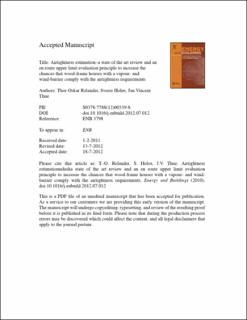| dc.contributor.author | Relander, Thor-Oskar | |
| dc.contributor.author | Holøs, Sverre Bjørn | |
| dc.contributor.author | Thue, Jan Vincent | |
| dc.date.accessioned | 2020-10-19T07:52:57Z | |
| dc.date.available | 2020-10-19T07:52:57Z | |
| dc.date.created | 2012-07-31T13:26:40Z | |
| dc.date.issued | 2012 | |
| dc.identifier.citation | Energy and Buildings. 2012, 54 444-452. | en_US |
| dc.identifier.issn | 0378-7788 | |
| dc.identifier.uri | https://hdl.handle.net/11250/2683503 | |
| dc.description.abstract | High airtightness is particularly important in order to achieve energy efficient buildings. Of this reason airtightness estimation is of interest. Over the past 30 years researchers have worked on airtightness estimation. This article is divided into two parts. The 1st part deals with earlier work on airtightness estimation. It is seen that there are relatively few references in the literature that deal with estimation of airtightness. None of the reviewed references argue that airtightness measurements can be replaced by estimates. The only reference that deals with airtightness estimation of wood-frame houses with high airtightness did not manage to find a correlation between the estimated and the measured airtightness.
For a contractor what really matters is not an estimate of the airtightness of the finished building, but a reliable means to be sure of reaching the airtightness requirement. It is therefore customary to perform blower-door tests stepwise during the construction process. First the airtightness of the building with the wind-barrier is measured, n50w. Then the airtightness of the finished building that also has a vapour barrier is measured, n50f. The airtightness requirement is set for n50f. Of various reasons it is not given that n50f < n50w for a given building, and consequently one should have an idea of what an upper limit of n50w should be in order to be confident to reach the n50f requirement. In the 2nd part of the article it will be shown how this upper limit of n50w can be found by statistical analysis based on systematic measurements of n50w and n50f as part of a quality assurance system. | en_US |
| dc.language.iso | eng | en_US |
| dc.publisher | Elsevier | en_US |
| dc.rights | Attribution-NonCommercial-NoDerivatives 4.0 Internasjonal | * |
| dc.rights.uri | http://creativecommons.org/licenses/by-nc-nd/4.0/deed.no | * |
| dc.title | Airtightness estimation – a state of the art review and an en route upper limit evaluation principle to increase the chances that wood-frame houses with a vapour- and wind-barrier comply with the airtightness requirements | en_US |
| dc.type | Peer reviewed | en_US |
| dc.type | Journal article | en_US |
| dc.description.version | acceptedVersion | en_US |
| dc.source.pagenumber | 444-452 | en_US |
| dc.source.volume | 54 | en_US |
| dc.source.journal | Energy and Buildings | en_US |
| dc.identifier.doi | 10.1016/j.enbuild.2012.07.012 | |
| dc.identifier.cristin | 936641 | |
| dc.description.localcode | © 2012. This is the authors’ accepted and refereed manuscript to the article. This manuscript version is made available under the CC-BY-NC-ND 4.0 license http://creativecommons.org/licenses/by-nc-nd/4.0/ | en_US |
| cristin.ispublished | true | |
| cristin.fulltext | postprint | |
| cristin.qualitycode | 2 | |

